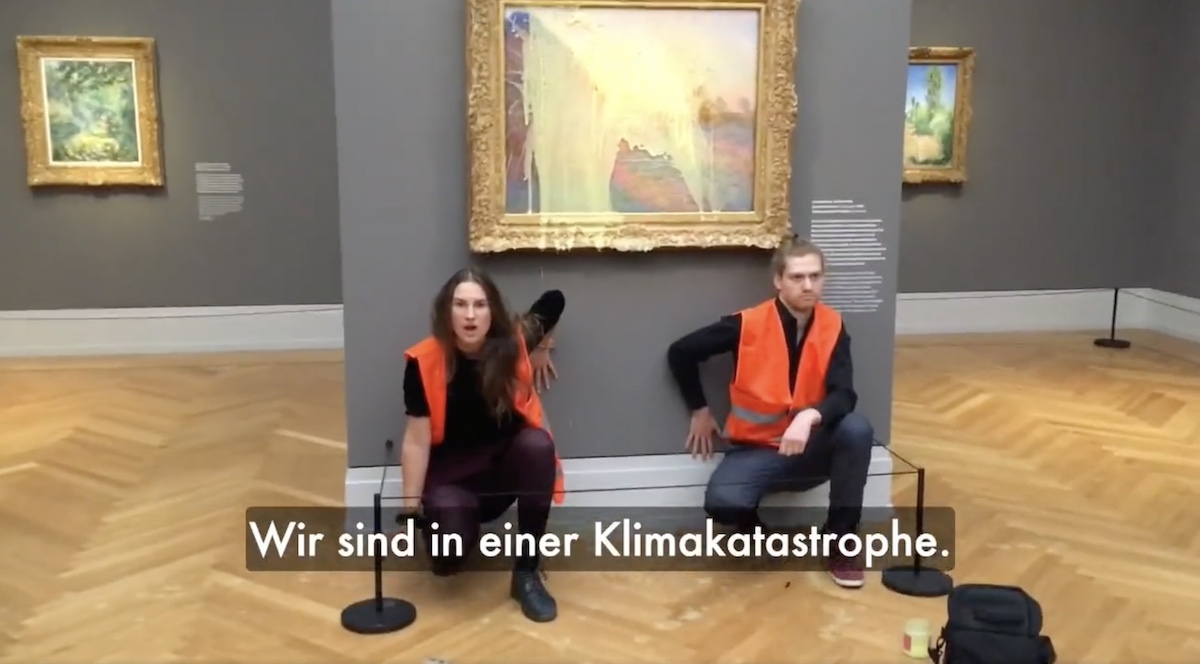WATCH: Climate Protesters Have ANOTHER Viral Tantrum, This Time With Monet and Mashed Potatoes

Screenshot via Twitter.
Here we go again. Anyone who’s ever been around a toddler understands that if you respond to the tantrum with a reward — by giving them the toy or cookie or whatever they’re demanding — you’re basically training the kid to throw tantrums. And that’s exactly what’s happening now, with the international media training climate protesters to throw food and glue themselves to walls in order to get publicity for their manifestos.
The latest group of climate protesters having a food fight with a priceless work of art were two Germans who threw mashed potatoes on a painting by French Impressionist Claude Monet, “Grainstacks,” at the Barberini Museum in Potsdam, Germany, and then glued their hands to the wall by the painting as they shouted about climate change.
This follows a similar stunt by two other protesters at a London museum who threw tomato soup on one of Vincent Van Gogh’s famous “Sunflowers” paintings and glued themselves to the wall.
“Grainstacks” is part of a series of 25 paintings Monet created in 1890-91 of the grain stacks in the fields near his house in Giverny, France, with the different works showing how he had “examined them systematically in different light and weather conditions,” according to the museum’s website. This specific painting last sold at auction in 2019 for $110.7 million.
The good news is that, like the soup-splattered Van Gogh,” the Monet was protected by glass and is unharmed, as the Museum confirmed in a tweet, and will return to exhibition this Wednesday.
The bad news is that these food-flinging protests show no signs of stopping.
The two who attacked the Monet were arrested and are being investigated for property damage and trespassing, according to NBC News, but that’s unlikely to result in a long sentence and there seems to an unending supply of young climate activists roaming around with weaponized groceries and bulk-purchased super glue.
The historic paintings being targeted by these protests are completely unrelated to the stated policy goals of the protesters; the museums’ mission is to educate and preserve art, not set climate policy.
The only reason these priceless works of art are getting pelted with food is because the protesters are hoping to “go viral” and get the media to amplify their messages — and they’re succeeding.
Just like with the Van Gogh, multiple news outlets identified the name of the protesters’ organization and quoted both the group’s website and the protesters’ comments at length. The media is literally rewarding the toddlers for having a tantrum.
As I wrote last week regarding the Van Gogh:
Rewarding these protesters by publicizing and amplifying their messages presents a very real risk of incentivizing more of this kind of protest.
The painting itself was thankfully unharmed this time, but the frame itself has historic value, and the media attention garnered by this stunt makes it more likely that another precious artwork may find itself covered in soup or paint. Even worse, it’s not inconceivable that the protesters may eventually decide they need to up the ante to continue to get attention and attack a painting that isn’t protected by plexiglass, causing real and irreparable damage.
The videos clips of soup, etc. splashing across a famous painting are shocking, and I’m not so naïve as to expect the media not to cover these stories. But again, reporting on the story does not require the media to mindlessly transcribe the protesters’ demands and amplify them to their international audiences.
Jim Acosta reported on the Kartoffel-kerfuffle on Sunday’s CNN Newsroom.
“The artwork was not damaged, as it’s protected by glass, thank goodness,” said Acosta. “This is the latest in a string of climate protests targeting works of art, including one earlier this month where demonstrators threw tomato soup on a Van Gogh painting at a London museum.”
“Maybe their parents should take their allowance away so they can’t buy mashed potatoes and tomato soup,” Acosta quipped. “Just a thought there.”
Indeed.
Watch the video above, via CNN.
This is an opinion piece. The views expressed in this article are those of just the author.




